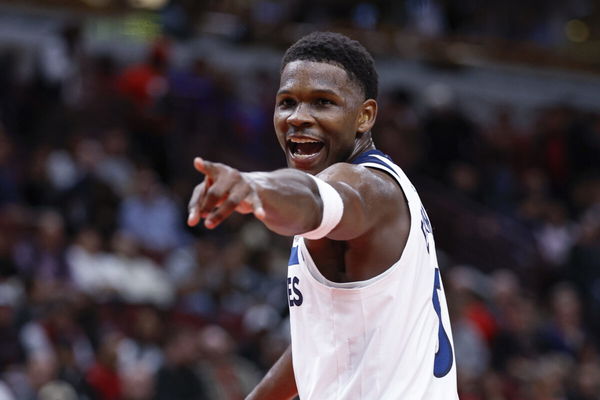
via Imago
Nov 7, 2024; Chicago, Illinois, USA; Minnesota Timberwolves guard Anthony Edwards (5) reacts after scoring against the Chicago Bulls during the second half at United Center. Mandatory Credit: Kamil Krzaczynski-Imagn Images

via Imago
Nov 7, 2024; Chicago, Illinois, USA; Minnesota Timberwolves guard Anthony Edwards (5) reacts after scoring against the Chicago Bulls during the second half at United Center. Mandatory Credit: Kamil Krzaczynski-Imagn Images
“This is very much a highlights-based sport,” this statement from Adam Silver created a ruckus. But the commissioner is sticking to it. The league recently approved a new rule to encourage players to take long heaves without it counting towards their statistics. The chase for highlight-worthy moments is only going to go up with the changes.
The rule, formalized at the NBA’s board of governors meeting, is straightforward but profound in its implications. Any shot launched from at least 36 feet away (roughly half-court territory) within the final three seconds of the first three quarters—on a possession originating in the backcourt—will be logged as a team field-goal attempt if missed. Makes still count for the individual, of course, but bricks? They vanish from personal shooting percentages, much like end-of-game intentional turnovers don’t ding a player’s assist-to-turnover ratio.
However, there have been arguments against it. Some don’t see value in it. Yet, there is. Making such shots can instantly change the game. There’s players who don’t hesitate. Anthony Edwards attempted the most triples last season, and has attempted 32 heaves since the 2020-21 season. Nikola Jokic leads the charts with 57. For such players, the rule rewards their courage.
ADVERTISEMENT
Article continues below this ad
And since it doesn’t count towards a player’s personal efficiency, some of the best shot makers won’t be worrying either. Notably, Kevin Durant has only attempted two heaves over the past five seasons. Jalen Brunson and Kawhi Leonard have both attempted fewer than 10, according to The Athletic. Of course, this might just be because of their philosophy.

via Imago
Feb 21, 2025; Houston, Texas, USA; Minnesota Timberwolves guard Anthony Edwards (5) reacts after scoring a basket during the second quarter against the Houston Rockets at Toyota Center. Mandatory Credit: Troy Taormina-Imagn Images
Basketball’s soul lies in its unpredictability. The end-of-quarter heave, that Hail Mary lob from beyond half-court, embodies this chaos more than any other play. It’s a low-percentage prayer (historically around a 4% success rate league-wide, per SportRadar data), but when it connects, it can jolt arenas, shift momentum, and even swing series.
By exempting missed heaves from individual player stats, the league is incentivizing risk-taking, potentially injecting more excitement into the grind of the regular season and playoffs. This isn’t just a minor adjustment; it’s a subtle evolution that rewards aggression over stat-padding caution, and it could redefine how bench players like Payton Pritchard thrive while echoing iconic moments like Jordan Poole’s 2022 Game 5 Finals dagger.
No player embodies the heave’s artistry—and the old rule’s frustration—quite like Boston Celtics guard Payton Pritchard. The 2024-25 NBA Sixth Man of the Year has built a cult following with his fearless long-range shots, making a record-setting 246 3-pointers off the bench last season while shooting 40.7% from deep overall. But it’s his end-of-quarter heroics that make him the rule’s poster child.
Pritchard’s not just attempting these shots; he’s mastering them, turning what was once a stat risk into a signature weapon. Take the 2024 NBA Finals: In Game 5’s clincher against the Mavericks, Pritchard drained a 43-foot buzzer-beater at halftime (logged as 43 feet per official NBA reports, though some cited 50 feet), inflating Boston’s lead to 21 and demoralizing Dallas en route to a 106-88 rout. It was the longest made Finals basket since 1997, a momentum-killer that echoed through the series.
What’s your perspective on:
Are long heaves the future of basketball strategy, or just a gimmick for highlight reels?
Have an interesting take?
It may have even been termed as a ‘bad shot’. However, coaches aren’t going to hold players back anymore. The impact of the new rule is going to be profound.
The three-point party is only going to get bigger
In the earlier eras, fans couldn’t fathom if teams were attempting a truckload of three-pointers per season. Now, the best shooting teams easily average over 1,000. This past season, the Celtics set the record with 1364 triples made. No team from before 2019 even ranks in the top 10. That shows just how valuable a three-pointer is in this age.
ADVERTISEMENT
Article continues below this ad
What do you think is going to happen when teams essentially get three free attempts at the end of the first three quarters?
Critics like Richard Jefferson have blasted it as “soft,” arguing it coddles stat-obsessed players rather than demanding all-out effort. True competitors like Doc Rivers (who once benched players for not heaving) wouldn’t need this nudge. But in a league where analytics rule, this rule levels the playing field, encouraging the bold without punishing the prudent.
It’s a relatively new rule, but teams are going to notice how valuable this can be. It doesn’t just open up All-Stars to take these shots regularly. It creates the possibility of it becoming a real strategy for teams. Of course, the efficiency on such shots is always going to be low because of how tough they really are. But it’s a free shot, and the league has never had more shooters in the league. Stephen Curry even believes it to be the most skilled era.
ADVERTISEMENT
Article continues below this ad
So the high-profile names aren’t just going to be happy that it won’t affect their statistics. They could easily begin working on such shots, noticing their potential to swing momentum. There’s no need to imagine. A shot of such nature at home will drive fans mad, which indirectly boosts morale for teams.
It’s still going to feel new. Players like Brunson and Kevin Durant might still be conservative with such shots. However, there’s almost an equal chance that they open themselves up to adding the skill to their repertoire.
ADVERTISEMENT
ADVERTISEMENT
ADVERTISEMENT
ADVERTISEMENT



Are long heaves the future of basketball strategy, or just a gimmick for highlight reels?